Chapter 13: Hedging foreign exchange risk
Chapter learning Objectives
Upon completion of this chapter you will be able to:
- explain the characteristics of the following and calculate the financial position after their use as hedging tools:
- forward contracts
- money market hedges
- exchange-traded currency futures contracts
- FOREX swaps
- currency swaps
- currency options
- explain the characteristics of synthetic foreign exchange agreements (SAFE’s)
- explain how bilateral and multilateral netting and matching tools work to minimise FOREX transactions costs and manage the market barriers to the free movement of capital and other remittances
- calculate the required payments for a party to a bilateral or multilateral net settlement system.
Many aspects of forex risk management were met in F9. These arerecapped briefly for completeness. In P4 the range of techniquesconsidered is extended.
1 Introduction
Types of forex risk
Firms may be exposed to three types of foreign exchange risk:
Transaction risk
- The risk of an exchange rate changing between the transaction date and the subsequent settlement date on an individual transaction.
- i.e. it is the gain or loss arising on conversion.
- Associated with exports/imports.
- Hedge using a variety of financial products/methods – see below.
Economic risk
- Includes the longer-term effects of changes in exchange rates on the market value of a company (PV of future cash flows).
- Looks at how changes in exchange rates affect competitiveness, directly or indirectly.
- Reduce by geographic diversification.
Translation risk
- How changes in exchange rates affect the translated value of foreign assets and liabilities (e.g. foreign subsidiaries).
- Can hedge by borrowing in local currency to fund investment.
- Gains/losses usually unrealised so many firms do not hedge.

 Types of foreign exchange risk
Types of foreign exchange risk
Transaction risk
Is the risk of an exchange rate changing between the transactiondate and the subsequent settlement date, i.e. it is the gain or lossarising on conversion.
This type of risk is primarily associated with imports and exports.If a company exports goods on credit then it has a figure for debtorsin its accounts. The amount it will finally receive depends on theforeign exchange movement from the transaction date to the settlementdate.
As transaction risk has a potential impact on the cash flows of acompany, most companies choose to hedge against such exposure. Measuringand monitoring transaction risk is normally an important component oftreasury management.
The degree of exposure involved, which is dependent on:
(a) The size of the transaction, is it material?
(b) The hedge period, the time period before the expected cash flows occurs.
(c) The anticipated volatility of the exchange rates during the hedge period.
The corporate risk management policy should state what degree ofexposure is acceptable. This will probably be dependent on whether theTreasury Department is been established as a cost or profit centre.
Economic risk
Transaction exposure focuses on relatively short-term cash flowseffects; economic exposure encompasses these plus the longer-termaffects of changes in exchange rates on the market value of a company.Basically this means a change in the present value of the future aftertax cash flows due to changes in exchange rates.
There are two ways in which a company is exposed to economic risk.
Directly: If your firm’s home currency strengthens thenforeign competitors are able to gain sales at your expense because yourproducts have become more expensive (or you have reduced your margins)in the eyes of customers both abroad and at home.
Indirectly: Even if your home currency does not movevis-à -vis your customer’s currency you may lose competitive position.For example suppose a South African firm is selling into Hong Kong SAR andits main competitor is a New Zealand firm. If the New Zealand dollarweakens against the Hong Kong SAR dollar the South African firm has lostsome competitive position.
Economic risk is difficult to quantify but a favoured strategy isto diversify internationally, in terms of sales, location of productionfacilities, raw materials and financing. Such diversification is likelyto significantly reduce the impact of economic exposure relative to apurely domestic company, and provide much greater flexibility to reactto real exchange rate changes.
Translation risk
The financial statements of overseas subsidiaries are usuallytranslated into the home currency in order that they can be consolidatedinto the group’s financial statements. Note that this is purely apaper-based exercise – it is the translation not the conversion ofreal money from one currency to another.
The reported performance of an overseas subsidiary in home-basedcurrency terms can be severely distorted if there has been a significantforeign exchange movement.
If initially the exchange rate is given by $/£1.00 and an Americansubsidiary is worth $500,000, then the UK parent company willanticipate a balance sheet value of £500,000 for the subsidiary. Adepreciation of the US dollar to $/£2.00 would result in only £250,000being translated.’
Unless managers believe that the company’s share price will fallas a result of showing a translation exposure loss in the company’saccounts, translation exposure will not normally be hedged. Thecompany’s share price, in an efficient market, should only react toexposure that is likely to have an impact on cash flows.

Hedging transaction risk – the internal techniques
Internal techniques to manage/reduce forex exposure should alwaysbe considered before external methods on cost grounds. Internaltechniques include the following:
Invoice in home currency
- One easy way is to insist that all foreign customers pay in your home currency and that your company pays for all imports in your home currency.
- However the exchange-rate risk has not gone away, it has just been passed onto the customer. Your customer may not be too happy with your strategy and simply look for an alternative supplier.
- Achievable if you are in a monopoly position, however in a competitive environment this is an unrealistic approach.
Leading and lagging
- If an importer (payment) expects that the currency it is due to pay will depreciate, it may attempt to delay payment. This may be achieved by agreement or by exceeding credit terms.
- If an exporter (receipt) expects that the currency it is due to receive will depreciate over the next three months it may try to obtain payment immediately. This may be achieved by offering a discount for immediate payment.
- The problem lies in guessing which way the exchange rate will move.
Matching
- When a company has receipts and payments in the same foreign currency due at the same time, it can simply match them against each other.
- It is then only necessary to deal on the forex markets for the unmatched portion of the total transactions.
- An extension of the matching idea is setting up a foreign currency bank account.
- Bilateral and multilateral netting and matching tools are discussed in more detail later in the chapter.
Decide to do nothing?
- The company would ‘win some, lose some’.
- Theory suggests that, in the long run, gains and losses net off to leave a similar result to that if hedged.
- In the short run, however, losses may be significant.
- One additional advantage of this policy is the savings in transaction costs.
2 Forward contracts
Characteristics
- The forward market is where you can buy and sell a currency, at a fixed future date for a predetermined rate, i.e. the forward rate of exchange.

 Test your understanding 1
Test your understanding 1
An Australian firm has just bought some machinery from a US supplierfor US$250,000 with payment due in 3 months time. Exchange rates arequoted as follows:

Determine the amount payable if a forward contract is used.

Availability and use
- Although other forms of hedging are available, forward cover represents the most frequently employed method of hedging.
- However, the existence and depth of forward markets depends on the level of demand for each particular currency.
- In the exam you need to consider; does the forward market exist and would it extend far enough into the future before you recommend it.
- For major trading currency like the $, £, Yen or Euro it can be up to 10 years forward. Normally forward markets extend six months into the future. Forward markets do not exist for the so-called exotic currencies.
Advantages and disadvantages
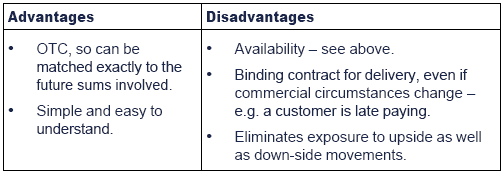

 Synthetic foreign exchange agreements
Synthetic foreign exchange agreements
Synthetic foreign exchange agreements (SAFE’s)
- Some governments have banned forward FX trading – usually as a means to reduce exchange rate volatility.
- For example:
- Brazilian Reals.
- Philippine Peso.
- Indian Rupee.
- Taiwan Dollars.
- Korean Won.
- Russian Ruble.
- Chinese Renminbi (or Yuan)
- In such markets the use of non-deliverable forwards (NDFs) has developed.
- These are like forward contracts, except no currency is delivered. Instead the profit or loss (i.e. the difference between actual and NDF rates) on a notional amount of currency (the face value of the NDF) is settled between the two counter parties.
- Combined with an actual currency exchange at the prevailing spot rate, this effectively fixes the future rate in a similar manner to futures.
- One other feature is that the settlement is in US dollars.
SAFE illustration
Let the spot rate between the US$ and the Brazilian Real be 1.6983Reals to $1 and suppose we agree a 3 month NDF to buy $1 million worthof Reals at 1.7000.
If the spot rate moves to 1.6800 in 3 months, then the counter-party will have to pay us 1million x 0.02 = 20,000 Reals.
This will be settled in US$, so the actual receipt will be 20,000/1.6800 = $11,905

3 Money market hedges
Characteristics
- The basic idea is to avoid future exchange rate uncertainty by making the exchange at today’s spot rate instead.
- This is achieved by depositing/borrowing the foreign currency until the actual commercial transaction cash flows occur:
- In effect a foreign currency asset is set up to match against a future liability (and vice-versa).

 Test your understanding 2
Test your understanding 2
Marcus is based in France has recently imported raw materials fromthe USA and has been invoiced for US$240,000, payable in three months’time.
In addition, it has also exported finished goods to Japan and Australia.
The Japanese customer has been invoiced for US$69,000, payable inthree months’ time, and the Australian customer has been invoiced forA$295,000, payable in four months’ time.
Current spot and forward rates are as follows:
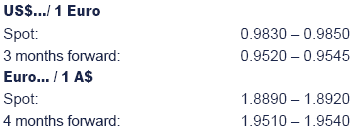
Current money market rates (pa) are as follows:

Show how the company can hedge its exposure to FX risk using:
(a) The forward markets
(b) The money markets
and in each case, determine which is the best hedging technique.

Further comments
- Interest rate parity implies that a money market hedge should give the same result as a forward contract.
- Money market hedges may be feasible as a way of hedging for currencies where forward contracts are not available.
- This approach has obvious cash flow implications which may prevent a company from using this method, e.g. if a company has a considerable overdraft it may be impossible for it to borrow funds now.
4 Futures contracts
Characteristics
- Futures contracts are standard sized, traded hedging instruments. The aim of a currency futures contract is to fix an exchange rate at some future date.
- A key issue with currency futures is to establish the ‘currency of the contract’ or CC. For example if the CC is $ and your transaction involves buying $, you should buy futures now to set up the hedge.
In exam questions the contract size will always be given to you, quoted in terms of the CC. For example,
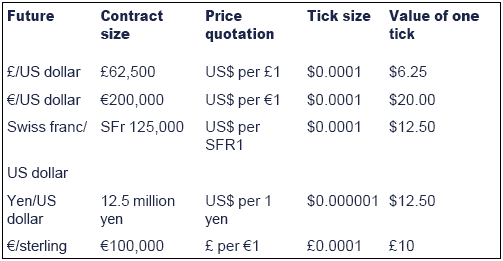
- The CC is the currency in which the contract size is quoted.
- We assume that the contracts mature or expire at the end of March, June, September and December. It is normal to choose the first contract to expiry after the conversion date.
- The range of available futures is limited and includes: $/£, $/Y, $/SFR, $/A$, $/C$ and $/€. Therefore if you are asked to give a hedge strategy for a ‘minor’ currency you should not recommend a futures contract.
Futures hedging calculations
Step 1: Set up the hedge by addressing 3 key questions:
- Do we initially buy or sell futures?
- How many contracts?
- Which expiry date should be chosen?
Step 2: Contact the exchange. Pay the initial margin. Then wait until the transaction / settlement date.
Step 3: Calculate profit or loss in the futures market by closingout the futures contracts, and calculate the value of the transactionusing the spot rate on the transaction date.

 Futures calculation
Futures calculation
It is 15 October and a treasurer has identified the need to converteuros into dollars to pay a US supplier $12 million on 20 November. Thetreasurer has decided to use December Euro futures contracts to hedgewith the following details:
- Contract size €200,000.
- Prices given in US$ per Euro (i.e. €1 = …).
- Tick size $0.0001 or $20 per contract.
He opens a position on 15 October and closes it on 20 November. Spot and relevant futures prices are as follows:

Calculate the financial position using the hedge described.
Solution
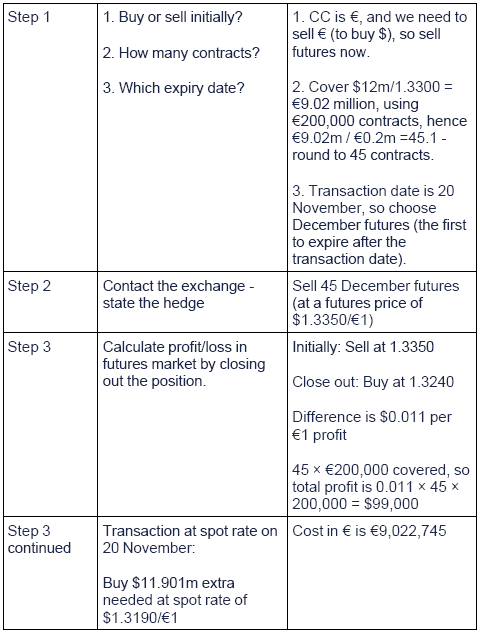


 Test your understanding 3
Test your understanding 3
It is 4 May and the treasurer of a Swiss company has identified a netreceipt of US$2 million on 10 June. These dollars will need to beconverted into Swiss Francs (CHF). The treasurer has decided to use USdollar – Swiss Franc futures contracts to hedge with the followingdetails:
- New York Board of Trade (NYBOT) options and futures exchange.
- Contract size $200,000.
- Prices given in Swiss francs per US dollar (i.e. $1 = …).
- Tick size CHF 0.0001 or CHF20 per contract.

The spot rate on 4 May is 1.2160 CHF/$1.
Required:
Calculate the financial position using the relevant futures hedge,assuming that the spot rate on 10 June is 1.2750 CHF/$1, and that thefutures price is 1.2760 CHF/$1.

5 Currency options
Characteristics
- A currency option is a right, but not an obligation, to buy or sell a currency at an exercise price on a future date. If there is a favourable movement in rates the company will allow the option to lapse, to take advantage of the favourable movement. The right will only be exercised to protect against an adverse movement, i.e. the worst-case scenario.
- A call option gives the holder the right to buy the underlying currency.
- A put option gives the holder the right to sell the underlying currency.
- Options are more expensive than the forward contracts and futures.
- A European option can only be exercised on the expiry date whilst an American option can be exercised at any time up to the expiry date.
OTC options
- Currency options can be bought OTC or on major exchanges.
- Like forward contracts, the OTC options are tailor made to fit a company’s precise requirements. Branches of foreign banks in major financial centres are generally willing to write options against their home currency.
- e.g. Australian banks in Chicago will write options on the Australian dollar.
- Option sizes are much larger on the OTC market, with most options being in excess of $1 million.
Exchange traded options
- Exchange traded options are also available but the OTC market is the larger.
- e.g. Euronext.liffe (formerly LIFFE) offers European style dollar:euro option contracts.
- Two types of currency option are available:
- Cash options contracting for delivery of the underlying currency.
- Options on currency futures.

 Illustration 1: Currency options
Illustration 1: Currency options
A typical pricing schedule for the US$/€ currency option on the Philadelphia exchange is as follows.

- Here, the options are for a contract size of €125,000 and prices (both strike price and premia) are quoted in US$ (cents) per €1.
- So to buy a call option on €125,000 with an expiry date of September and at a strike price of €1 = $1.17 would cost 1.55 cents per euro, or $1,937.50.
- Similarly, the premium on a June put at a strike price of 115.00 (€1 = $1.15) would cost 0.64 cents per euro, or $800.
- The decision as to which exercise price to choose will depend on cost, risk exposure and expectations. If you have to choose in the exam then one approach is to consider the cost implications only for calculation purposes: The best exercise price is then the one which (incorporating the premium cost) is most financially advantageous.


 Choosing an exercise price
Choosing an exercise price
Call option
Using the above schedule, determine which June call option would give the lowest net cost of acquiring euros.

The lowest cost would involve using call options with a strike price of 115.
Put option
Using the above schedule, determine which September put option would give the highest net receipt from selling euros.

The highest receipt would involve using put options with a strike price of 117.

Options hedging calculations
Step 1: Set up the hedge by addressing 4 key questions:
- Do we need call or put options?
- How many contracts?
- Which expiry date should be chosen?
- Which strike price / exercise price should be used?
Step 2: Contact the exchange. Pay the upfront premium. Then wait until the transaction / settlement date.
Step 3: On the transaction date, compare the option price with theprevailing spot rate to determine whether the option should be exercisedor allowed to lapse.
Step 4: Calculate the net cash flows - beware that if the number ofcontracts needed rounding, there will be some exchange at theprevailing spot rate even if the option is exercised.

 Test your understanding 4: Pongo
Test your understanding 4: Pongo
Pongo plc is a UK-based import-export company. It has an invoice, which it is due to pay on 30 June, in respect of $350,000.
The company wishes to hedge its exposure to risk using traded options.
The current $/£ spot rate is 1.5190 – 1.5230.
On Euronext.liffe, contract size is £25,000.

Option premia are given in cents per £.
Assume that it is now the 31 March and that UK £ interest rates are 12%.
Calculate the cash flows in respect to the payment if the spot rate is: 1.4810 – 1.4850 on the 30 June


 Test your understanding 5: Pongo (continued)
Test your understanding 5: Pongo (continued)
Using the circumstances described in the previous example above,suppose Pongo plc is also due to receive $275,000 from a US customeron 30 September. Euronext.liffe quotes for September option contractsare as follows:

Calculate the cash flows in respect to the receipt if the spot rate is 1.5250 – 1.5285 on the 30 September.

6 Forex swaps
Characteristics
- In a forex swap, the parties agree to swap equivalent amounts of currency for a period and then re-swap them at the end of the period at an agreed swap rate. The swap rate and amount of currency is agreed between the parties in advance. Thus it is called a ‘fixed rate/fixed rate’ swap.
- The main objectives of a forex swap are:
- To hedge against forex risk, possibly for a longer period than is possible on the forward market.
- Access to capital markets, in which it may be impossible to borrow directly.
- Forex swaps are especially useful when dealing with countries that have exchange controls and/or volatile exchange rates.

 Illustration 2
Illustration 2
Suppose that A plc, a UK construction company, wins a contract toconstruct a bridge in Argentina. The bridge will require an initialinvestment now, and will be sold to the Argentinean Government in oneyear’s time. The Government will pay in pesos.
The problem is the company’s exposure to currency risk. They knowhow much will be received in one year’s time in pesos but not insterling as the exchange rate changes daily.
Various possible hedging strategies:
(1) Decide to do nothing, i.e. accept the risk – win some, lose some.
(2) Lock into a forward contract for converting the amount receivable in one year’s time into sterling, if a forward market exists.
(3) Undertake a money market hedge:take out a loan in pesos to cover the initial cost, and repay the loanfrom the disposal proceeds in a year’s time. We would then only beexposed on the profit we make (if we make any).
(4) Enter into a forex swap. Instead of taking out a loan in pesos we
(a) Swap sterling today for the pesos required to cover the initial investment, at an agreed swap rate.
(b) Take out a loan in sterling today to buy the pesos.
(c) In one year’s time (in this example) arrange to swap back the pesos obtained in (a) for pounds at the same swap rate.
(d) Just like taking out aloan in pesos we are therefore only exposed on the profit that we make.We could of course use another hedging technique to hedge the profitelement.

Calculations

 Illustration 3
Illustration 3
Say the bridge will require an initial investment of 100m pesos and is will be sold for 200m pesos in one year’s time.
The currency spot rate is 20 pesos/£, and the government hasoffered a forex swap at 20 pesos/£. A plc cannot borrow pesos directlyand there is no forward market available.
The estimated spot rate in one year is 40 pesos/£. The current UK borrowing rate is 10%.
Determine whether A plc should do nothing or hedge its exposure using the forex swap.
Solution

A plc should use a forex swap.
(Key idea: The forex swap is used to hedge foreign exchangerisk. We can see that in this basic exercise that the swap amount of100m pesos is protected from any deprecation, as it is swapped at boththe start and end of the year at the swap rate of 20, whilst in the spotmarket pesos have depreciated from a rate of 20 to 40 pesos per pound.)


 Test your understanding 6
Test your understanding 6
Goldsmith Co, a mining company based in the fictitious country ofKrownland, wishes to hedge 1 year foreign exchange risk, which willarise on an investment in Chile. The investment is for 800m escudos andis expected to yield an amount of 1000m escudos in 1 year’s time.
Goldsmith cannot borrow escudos directly and is therefore considering two possible hedging techniques:
(a) Entering into a forward contract for the full 1000m escudos receivable.
(b) Entering into a forex swapfor the 800m escudos initial investment, and then a forward contract forthe 200m escudos profit element.
The currency spot rate is 28 escudos to the krown, and the bank hasoffered a forex swap at 22 escudos/krown with Goldsmith making a netinterest payment to the bank of 1% in krowns (assume at T1).

A forward contract is available at a rate of 30 escudos per krown.
Determine whether Goldsmith should hedge its exposure using a forward contract or a forex swap.

7 Currency swaps
Characteristics
- A currency swap allows the two counterparties to swap interest rate commitments on borrowings in different currencies.
- In effect a currency swap has two elements:
- An exchange of principal in different currencies, which are swapped back at the original spot rate – just like a forex swap.
- An exchange of interest rates – the timing of these depends on the individual contract.
- The swap of interest rates could be ‘fixed for fixed’ or ‘fixed for variable’.

 Illustration 4
Illustration 4
Warne Co is an Australian firm looking to expand in Germany and isthus looking to raise €24 million. It can borrow at the followingfixed rates:
A$ 7.0%
€ 5.6%
Euroports Inc is a French company looking to acquire an Australianfirm and is looking to borrow A$40 million. It can borrow at thefollowing rates:
A$ 7.2%
€ 5.5%
The current spot rate is A$1 = €0.6.
Show how a ‘fixed for fixed’ currency swap would work in thecircumstances described, assuming the swap is only for one year and thatinterest is paid at the end of the year concerned.
Solution

Net result:



 Test your understanding 7
Test your understanding 7
Wa Inc is a Japanese firm looking to expand in the USA and is lookingto raise $20 million at a variable interest rate. It has been quotedthe following rates:

McGregor Inc is an American company looking to refinance a ¥2,400m loan at a fixed rate. It can borrow at the following rates:

The current spot rate is $1 = ¥120.
Show how the ‘fixed for variable’ currency swapwould work in the circumstances described, assuming the swap is only forone year and that interest is paid at the end of the year concerned.

8 Bilateral and multilateral netting and matching agreements
Introduction

 Netting and matching
Netting and matching
Netting and matching are carried out to reduce the scale of external hedging required.
For example, Group X is expecting to receive $10 million in onesubsidiary and pay $6 million at the same time in another subsidiary.Clearly the group only has a net exposure of a receipt of $4 million.
The terms ‘netting’ and ‘matching’ are often used interchangeably but strictly speaking they are different:
- Netting refers to netting off group receipts and payments, as in the example above.
- Matching extends this concept to include third parties such as external suppliers and customers.

Calculations
The calculations can be presented in one of two ways: the tabularmethod and the diagrammatical method. Both are explained below.
Tabular method
Step 1: Set up a table with the name of each company down the side and across the top.
Step 2: Input all the amounts owing from one company to anotherinto the table and convert them into a common (base) currency (at spotrate).
Step 3: By adding across and down the table, identify the total amount payable and the total amount receivable by each company.
Step 4: Compute the net payable or receivable, and convert back into the original currency.
Diagrammatical method
Step 1: Convert all currency flows to a common (‘base’) currency using spot rates (NOT forward or future rates).
Step 2: Clear the overlap of any bi-lateral indebtedness.
E.g.
Step 3: Clear the smallest leg of any 3 way circuits.
E.g.
Step 4: Clear the smallest leg of any 4 way circuits (then 5, etc).
E.g.
Step 5: Convert back into original currencies.
Step 6: Use the simplified figures for:
A Settlement
B Setting up appropriate hedging tools.

 Test your understanding 8: Netting and matching
Test your understanding 8: Netting and matching
X, Y, and Z are three companies within the same UK based internationalgroup. W is a company outside of the group. The following liabilitieshave been identified for the forthcoming year:

Establish the net indebtedness that would require external hedging.

9 Chapter summary
Test your understanding answers

 Test your understanding 1
Test your understanding 1
Step 1: Get the appropriate spot rate from the spread (remember the bank always wins): 0.7785.
Step 2: Adjust to get the forward rate (remember to add discounts and deduct premiums) 0.7785 - 0.0021 = 0.7764.
Step 3: Use the rate: cost = 250,000/0.7764 = A$ 322,000 CERTAIN SUM.


 Test your understanding 2
Test your understanding 2
1 US$ exposure
As Porto plc has a US$ receipt (US$69,000) and payment(US$240,000), maturing at the same time (3 months), they can match themagainst each other to leave a net liability of US$ 171,000 to be hedged.
Forward market hedge
Buy US$171,000 3 months forward at a cost of:
US$171,000/0.9520 = (€179,622) payable in 3 months time.
Money market hedge
This is cheaper than the forward market hedge.
Note: Interest rates can simply be time-apportioned.
2 A$ exposure
Forward market hedge
Sell A$295,000 4 months forward to produce a receipt of:
A$295,000 × 1.9510 = €575,545 receivable in 4 months time.
Money market hedge
As this is smaller amount than received from the forward markethedge, we can conclude that the forward market hedge gives the betteroutcome.


 Test your understanding 3
Test your understanding 3
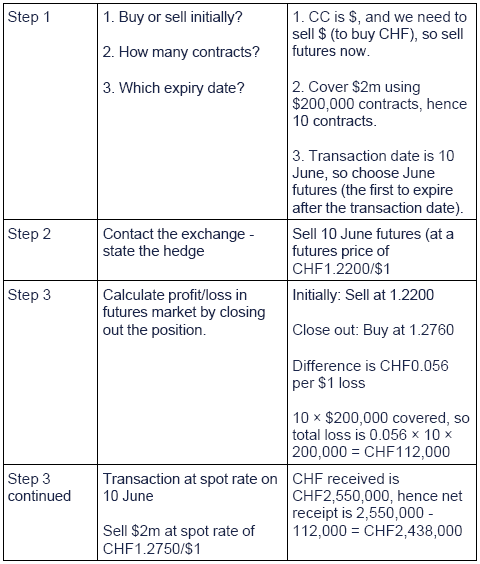


 Test your understanding 4: Pongo
Test your understanding 4: Pongo
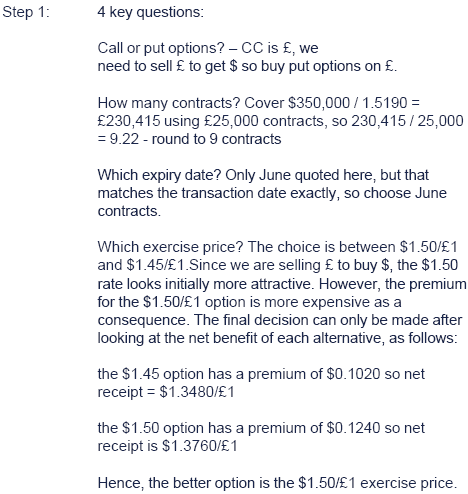

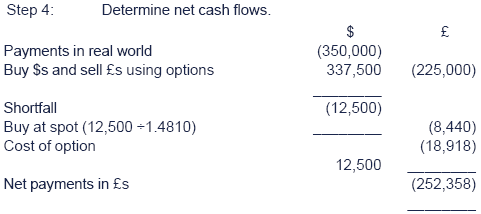


 Test your understanding 5: Pongo (continued)
Test your understanding 5: Pongo (continued)
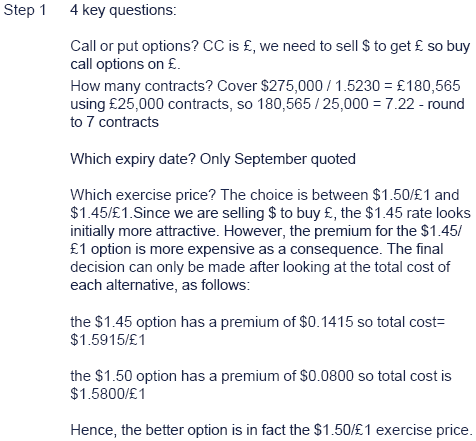
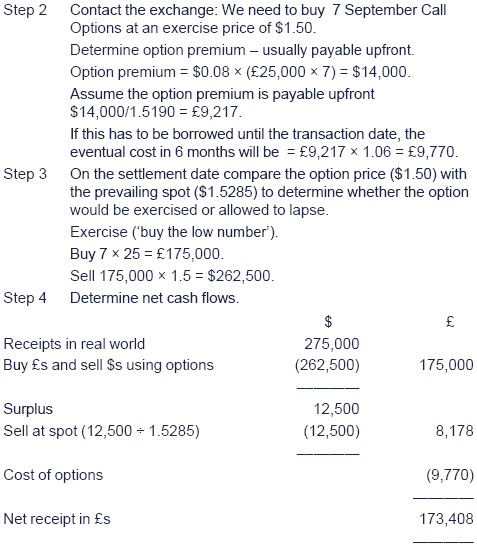


 Test your understanding 6
Test your understanding 6
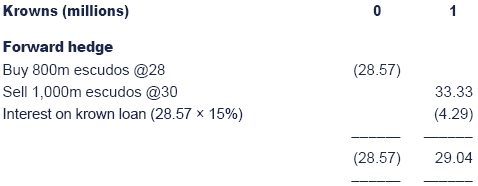
Net receipt of 0.47 million krowns.
With forex swap and forward
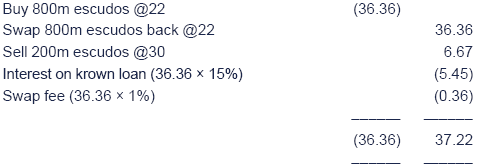
Net receipt of 0.86 million krowns.
Goldsmith should use a forex swap.


 Test your understanding 7
Test your understanding 7
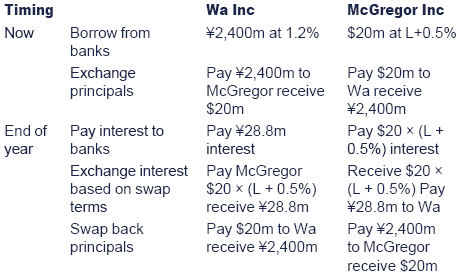
Net result:



 Test your understanding 8: Netting and matching
Test your understanding 8: Netting and matching
Tabular method

These amounts represent amounts owed BY the firm in the left hand column TO the firm listed across the top.
Now convert to £ at spot rate, and add across and down:
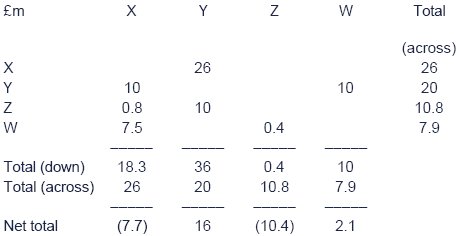
The easiest way to interpret this is for X and Z to pay £7.7m and£10.4m respectively to Y (which now receives £18.1m in total). If Ythen pays £2.1m to W, all companies have the correct net payments orreceipts.
Convert these back into the original currencies and the final transactions are:
X pays Y €11.55m
Z pays Y €15.6m
Y pays W $4.2m
Diagrammatical method:
The current position can be shown in a diagram as follows:
Step 1: Convert to base – here GB pounds.
Step 2: Clear bilateral indebtedness.
Step 3: Identify and clear 3 way circuits
(a) XYW
(b) ZXY
(c) YWZ
Final step: Convert back to original currencies.
Step 6: The only intra-group settlement needed is for Z to pay Y €15.6m and X to pay Y €11.55m.
The final hedging tools needed for the group are for a payment of $4.2m to W.

|
Created at 5/24/2012 3:57 PM by System Account
(GMT) Greenwich Mean Time : Dublin, Edinburgh, Lisbon, London
|
Last modified at 5/25/2012 12:55 PM by System Account
(GMT) Greenwich Mean Time : Dublin, Edinburgh, Lisbon, London
|
|
|
|
 |
Rating
:
|
 Ratings & Comments
(Click the stars to rate the page) Ratings & Comments
(Click the stars to rate the page)
|
 |
Tags:
|
|